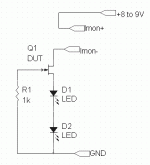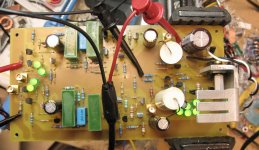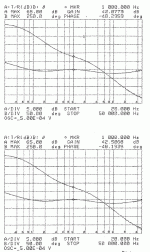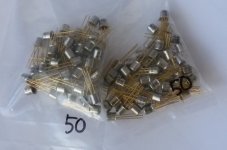BTW, Avago (formerly the semiconductor component division of HP) still appear to make a "standard red" part, the HLMP-6000, with the typical 1.6V forward voltage and low brightness (1.2 millicandela). Digikey even sells them. They are in a rather peculiar package with ribbon leads iirc.
I may have a few floating around, but I don't recall measuring the slope resistance with current.
I may have a few floating around, but I don't recall measuring the slope resistance with current.
I have some of the ribbon lead packaged LEDS The early vendors like Monsanto all offered LEDs in that style, possibly for mil applications, maybe the same reason that HP/Avago still offers them, as the mil guys want stuff available until doomsday... The standard 5mm package is easier to deal with if you can find them.
For TO-18 heat sinking, especially as the power handling is not out on the bleeding edge, Thermalloy and others have a slip-on radiator that doesn't have the lead length issues, though it requires some room around the part for the fins. I just nabbed some on E-pay, as it would probably take me hours to find the ones I have squirreled away.
Linear Systems also appears to have a replacement for the 2N4391 (LS4391), and it may be easier to buy.
For TO-18 heat sinking, especially as the power handling is not out on the bleeding edge, Thermalloy and others have a slip-on radiator that doesn't have the lead length issues, though it requires some room around the part for the fins. I just nabbed some on E-pay, as it would probably take me hours to find the ones I have squirreled away.
Linear Systems also appears to have a replacement for the 2N4391 (LS4391), and it may be easier to buy.
Last edited:
I've used the LIS 4391 in surface mount as a bootstrapped cascode device for their SK170 in surface mount, and both seemed to work fine (although the company the design was for has fallen apart, four of us (the tech team and one marketing guy) realizing that the one guy was a con artist and all quitting at the same time. It has not been a good period for startups for me!
Correction: thinking about it I realized that it was indeed a SOT-23 LSK170, but probably a Fairchild 4391 (in SM). However I'm confident the LIS part is just fine.
I picked up 500 pieces of PN4391 to tide me over for a while. Even if I don't pursue this preamp option very vigorously, it's my favorite device for cascoding other N-channel jfets.
I just pursued a matching exercise with both 2SK364BL and PN4391 parts, following up on a claim I made in another diy thread about paralleling bunches of parts based on a simple presort measuring on resistance. My aim is to validate a simple sort-of-algorithmic approach to matching and, with the possible exception of wildly discrepant outliers, employ all tested parts. So far it looks quite promising. The intention is to use the 364s and 4391 in cascoded pairs, joining them all together as composite devices, possibly with a little passive external R in each 364 drain lead to suppress parasitic oscillations. Intuition tells me about 20 ohms for each will suffice, given a tight-enough layout.
But I should buy some more 4391s.
BTW the 364 is the same chip as the 170, just characterized for analog switching, in case I failed to mention that before (I'm sure I did in the other thread). I just happen to have a bunch of them from a project shutdown throwaway, years ago.
But I should buy some more 4391s.
BTW the 364 is the same chip as the 170, just characterized for analog switching, in case I failed to mention that before (I'm sure I did in the other thread). I just happen to have a bunch of them from a project shutdown throwaway, years ago.
I'm retrofitting a RIAA board design I already have with a front end based on the circuit in post #12. I've been having trouble getting devices to match using my usual fet sorting jig, which measures Vgs vs. drain current. I'm going to try a different approach which may result in better matched devices. I'll sort for drain current using a fixed bias consisting of a pair of LEDS. I've been finding that the PN4391s I have in stock are quite a bit "hotter" than the model provided in PSpice, so I'll need to use a higher bias voltage than anticipated. I'll start the sorting run using a series pair of yellow-green HP GaP LEDS (~2V drop apiece, ~13 ohms incremental impedance). We'll see what happens from there. The supply voltage will be set somewhere between 8-9V to approximate the voltage seen by the devices in the actual circuit.
Attachments
Using the circuit posted above with two HP GaP yellow-green LEDs in the source, I was able to quickly match up two pieces of my old Vishay 4391 stock to within a couple of tenths of a milliamp drain current. I tried some of the National 4391s, and they would need at least another series LED to tame them - way too hot...
I haven't cracked into my recent purchase of Fairchild parts. It'll be interesting to see how they measure up when I do.
I haven't cracked into my recent purchase of Fairchild parts. It'll be interesting to see how they measure up when I do.
The matched fets are now in the front end of my RIAA preamp, which is a passive setup now using the PN4391 in both input and output duty. I may sneal into work tomorrow and run a scan on the finished preamp - if so, I'll post the results.
If this actually works out OK, then it will result in and all-4391 RIAA preamp/lineamp, as my currently employed line amp is a PN4391 with a few helpers (see the "Liniac revisited" thread for circuit).
Last edited:
Here's the gain-phase plots. The 1kHz gain between the two channels is off by ~0.4 dB. I'll be trying to bring that closer by better matching between jfets and also for the current sources feeding them. Meanwhile, I want to throw the current revision preamp into my system to see if the extra care will be worthwhile.
Attachments
I picked up 100X NSC 2n4391s from a Chinese E-pay seller - It'll be interesting to see how they test out. The NSC PN4391s I've tested have so far been on the "hot" side in terms of Vgs for a modest drain current.
Date code may be 9411. I don't know when National unloaded their discrete lineup, but if this date is after that, then they would be fakes. I don't see why anyone would bother to put fake fets in gold-plated TO-18 packages, though, unless these parts are some other device that was scrubbed clean and re-marked. I plan to put a couple through my fet tester to see if they make noises like a typical 4391. This may not happen until I get back from a business trip to China. If they are legit, I have just the heat sink for them...
I did a little digging using Google, and it appears that National dumped their discrete lineup in 1996 when they spun off Fairchild as a separate entity.
If those are still available I'd be interested in the contact. Also, if you find it convenient I'd like to know what their typical drain-source breakdown voltage is running (don't destroy one in the process, but say when does the drain-gate zener with a 10M resistor in series?).
Clearly, I don't have these in mind for a production run 🙂
Brad
Clearly, I don't have these in mind for a production run 🙂
Brad
Easy, just search for 2N4391 on E-pay. The source is the only one offering National 2N4391 in quantity. The price is merely obscenely extortionate as compared to hilariously extortionate. If these are real 4391s, they are rated for 40V, though no doubt some will break down at a higher voltage.
- Status
- Not open for further replies.
- Home
- Source & Line
- Analogue Source
- Folded Cascode Hijinks with PN4391



